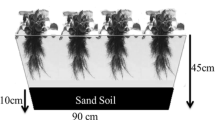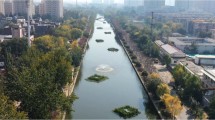Abstract
The research and interest towards the use of constructed floating wetlands for (waste)water treatment is emerging as more treatment opportunities are marked out, and the technique is applied more often. To evaluate the effect of a floating macrophyte mat and the influence of temperature and season on physico-chemical changes and removal, two constructed floating wetlands (CFWs), including a floating macrophyte mat, and a control, without emergent vegetation, were built. Raw domestic wastewater from a wastewater treatment plant was added on day 0. Removal of total nitrogen, NH4–N, NO3–N, P, chemical oxygen demand (COD), total organic carbon and heavy metals (Cu, Fe, Mn, Ni, Pb and Zn) was studied during 17 batch-fed testing periods with a retention time of 11 days (February–March 2007 and August 2007–September 2008). In general, the CFWs performed better than the control. Average removal efficiencies for NH4–N, total nitrogen, P and COD were respectively 35%, 42%, 22% and 53% for the CFWs, and 3%, 15%, 6% and 33% for the control. The pH was significantly lower in the CFWs (7.08 ± 0.21) than in the control (7.48 ± 0.26) after 11 days. The removal efficiencies of NH4–N, total nitrogen and COD were significantly higher in the CFWs as the presence of the floating macrophyte mat influenced positively their removal. Total nitrogen, NH4–N and P removal was significantly influenced by temperature with the highest removal between 5°C and 15°C. At lower and higher temperatures, removal relapsed. In general, temperature seemed to be the steering factor rather than season. The presence of the floating macrophyte mat restrained the increase of the water temperature when air temperature was >15°C. Although the mat hampered oxygen diffusion from the air towards the water column, the redox potential measured in the rootmat was higher than the value obtained in the control at the same depth, indicating that the release of oxygen from the roots could stimulate oxygen consuming reactions within the root mat, and root oxygen release was higher than oxygen diffusion from the air.




Similar content being viewed by others
References
Akratos, C. S., & Tsihrintzis, V. A. (2007). Effect of temperature, HRT, vegetation and porous media on removal efficiency of pilot-scale horizontal subsurface flow constructed wetlands. Ecological Engineering, 29, 173–191.
Allen, W. C., Hook, P. B., Biederman, J. A., & Stein, O. R. (2002). Temperature and wetland plant species effects on wastewater treatment and root zone oxidation. Journal of Environmental Quality, 31, 1010–1016.
Armstrong, W., Armstrong, J., & Beckett, P. M. (1990). Measurement and modelling of oxygen release from roots of Phragmites australis. In P. F. Cooper & B. C. Findlater (Eds.), Constructed wetlands in water pollution control (pp. 41–45). Oxford: Pergamon.
Baptista, J. (2003). Microbial communities in subsurface flow wetlands. 1st International Seminar on the use of aquatic macrophytes for wastewater treatment in constructed wetlands, 8–10 May 2003, Lisbon, Portugal, 265–276
Baquerizo, B., Maestre, J. P., Machado, V. C., Gamisans, X., & Gabriel, D. (2002). Long-term ammonia removal in a coconut fiber-packed biofilter: Analysis of N fractionation and reactor performance under steady-state and transient conditions. Water Research, 43, 2293–2301.
Boutwell, J. E. (2002). Water quality and plant growth evaluations of the floating islands in Las Vegas Bay, Lake Mead, Nevada. Technical Memorandum No. 8220-03-09, 69 p.
Brix, H. (1997). Do macrophytes play a role in constructed treatment wetlands? Water Science and Technology, 35(5), 11–17.
Coleman, J., Hench, K., Garbutt, K., Sexstone, A., Bissonnette, G., & Skousen, J. (2001). Treatment of domestic wastewater by three plant species in constructed wetlands. Water, Air, and Soil Pollution, 128, 283–295.
DeBusk, T., & Hunt, P.G. (2005). Use of floating artificial wetlands for denitrification. Paper presented at ASA-CSSA-SSSA International Annual Meeting, November 6–10, 2005, Salt Lake City, UT.
Del Bubba, M., Lepri, L., Griffini, O., & Tabani, F. (2000). Nitrogen removal in a pilot-scale subsurface horizontal flow constructed wetland. Annali di Chimica, 90, 513–524.
Dusek, J., Picek, T., & Cizkova, H. (2008). Redox potential dynamics in a horizontal subsurface flow constructed wetland for wastewater treatment: Diel, seasonal and spatial fluctuations. Ecological Engineering, 34, 223–232.
Eaton, A. D., Clesceri, L. S., & Greenberg, A. E. (1995). Standard methods for the examination of water and wastewater (p. 1325). Washington: American Health Organisation.
Garbett, P. (2005). An investigation into the application of floating reedbed and barley straw techniques for the remediation of eutrophic waters. Journal of the Chartered Institution Water and Environmental Management, 19(3), 174–180.
Gonzalez, J. F., de Miguel Beascoechea, E., de Miguel Muñoz, J., & Curt, M. D. (2005). Manual de fitodepuración. Filtros de macrofitas en floatación. End report of the LIFE project Nuevos filtros verdes de macrofitas en floatción para la cuence mediterránea, 143 p. http://www.fundacionglobalnature.org/macrophytes/Manual%20sobre%20fitodepuracion.htm. Consulted May 2009.
Gray, I. (2005). Floating reed beds for tertiary/storm sewage treatment. Cutting Edge Wetland Technology. 11 May, 2005, Derby, UK.
Headley, T. R., & Tanner, C. C. (2006). Application of CFWs for enhanced stormwater treatment: A review. Auckland Regional Council, Technical Publication No 324, p. 98.
Headley, T. R., & Tanner, C. C. (2008). Floating treatment wetlands for the removal of fine particulates, copper and zinc from stormwater. 11th International Conference on Wetland Systems for Water Pollution Control, 1–7 November 2008, Indore, India (cd-rom).
Hill, D. T., & Payton, J. D. (2000). Effect of plant fill ratio on water temperature in constructed wetlands. Bioresource Technology, 71, 283–289.
Hogg, E. H., & Wein, R. W. (1988a). Seasonal change in gas content and buoyancy of floating Typha mats. J Ecol, 76(4), 1055–1068.
Hogg, E. H., & Wein, R. W. (1988b). The contribution of Typha components to floating mat buoyancy. Ecology, 69(4), 1025–1031.
Huang, Y., Ortiz, L., Aguirre, P., Garcia, J., Mujeriego, R., & Bayona, J. M. (2005). Effect of design parameters in horizontal flow constructed wetland on the behaviour of volatile fatty acids and volatile alkylsulfides. Chemosphere, 59, 769–666.
Hubbard, R. K., Gascho, G. J., & Newton, G. L. (2004). Use of floating vegetation to remove nutrients from swine manure wastewater. Transactions of the ASAE, 47(6), 1963–1972.
Iamchaturapatr, J., Yi, S. W., & Rhee, J. S. (2007). Nutrient removals by 21 aquatic plants for vertical free surface-flow (VFS) constructed wetland. Ecological Engineering, 29, 287–293.
Kadlec, R. H. (1998). Wetland utilization for management of community wastewater, 1997. Operations Summary. Report to Michigan Department Natural Resources. Houghton Lake Treatment Wetland Project.
Kadlec, R. H. (1999). Chemical, physical and biological cycles in treatment wetlands. Water Science and Technology, 40(3), 37–44.
Kadlec, R. H., & Knight, R. L. (1996). Treatment wetlands (p. 928). Boca Raton: Lewis.
Kadlec, R. H., & Reddy, K. R. (2001). Temperature effects in treatment wetlands. Water Environment Research, 73, 543–557.
Kuschk, P., Wiessner, A., Kappelmeyer, U., Weissbrodt, E., Kastner, M., & Stottmeister, U. (2003). Annual cycle of nitrogen removal by a pilot-scale subsurface horizontal flow in a constructed wetland under moderate climate. Water Research, 37, 4236–4242.
Kyambadde, J., Kansiime, F., Gumaelius, L., & Dalhammar, G. (2004). A comparative study of Cyperus papyrus and Miscanthidium violaceum-based constructed wetlands for wastewater treatment in a tropical climate. Water Research, 38(2), 475–485.
Leitão, R. C., van Haandel, A. C., Zeeman, G., & Lettinga, G. (2006). The effects of operational and environmental variations on anaerobic wastewater treatment systems: A review. Bioresource Technology, 97, 1105–1118.
Maehlum, T., & Stalnacke, P. (1999). Removal efficiency of three cold-climate constructed wetlands treating domestic wastewater: Effects of temperature, seasons, loading rates and input concentrations. Water Science and Technology, 40(3), 273–281.
Mander, U., Kuusemets, V., Oovel, M., Ihme, R., Sevola, P., & Pieterse, A. (2000). Experimentally constructed wetlands for wastewater treatment in Estonia. Journal of Environmental Science Health Part A, 35, 1389–1401.
Mitsch, W. J., & Gosselink, J. G. (1993). Wetlands (2nd ed.). New York: Wiley.
Nakamura, K., & Shimatani, Y. (1997). Water purification and environmental enhancement by the floating wetland. In: Proceedings Asia WATERQUAL ’97. May 20–23 1997 (pp. 888–895). Seoul, Korea.
Oshima, H., Karasawa, K., & Nakamura, K. (2001). Water purification experiment by artificial floating island. Proceedings JSWE, 35, 146.
Picard, C. R., Fraser, L. H., & Steer, D. (2005). The interacting effects of temperature and plant community type on nutrient removal in wetland microcosms. Bioresource Technology, 96, 1039–1047.
Revitt, D. M., Shutes, R. B. E., Llewellyn, N. R., & Worrall, P. (1997). Experimental reed bed systems for the treatment or airport runoff. Water Science and Technology, 36(8–9), 385–390.
Riley, K. A., Stein, O. R., & Hook, P. B. (2005). Ammonium removal in constructed wetland microcosms as influenced by season and organic carbon load. Journal of Environmental Science and Health Part A, 40, 1109–1121.
Smith, M. P., & Kalin, M. (2000). Floating wetland vegetation covers for suspended solids removal. In: Proceedings of the Quebec 2000: Millennium Wetland Event, Quebec City, Quebec, August 6–12, p. 244.
Spieles, D. J., & Mitsch, W. J. (2000). The effects of season and hydrologic and chemical loading on nitrate retention in constructed wetlands: A comparison of low and high nutrient riverine systems. Ecological Engineering, 14, 77–91.
Stein, O. R., & Hook, P. B. (2005). Temperature, plants and oxygen: How does season affect constructed wetland performance? Journal of Environmental Science and Health Part A, 40, 1331–1342.
Sundaravadivel, M., & Vigneswaran, S. (2001). Constructed wetlands for wastewater treatment. Critical Reviews in Environmental Science and Technology, 31, 351–409.
Tanner, C. C., Clayton, J. S., & Upsdell, M. P. (1995). Effect of loading rate and planting on treatment of dairy farm wastewaters in constructed wetlands—II. Removal of nitrogen and phosphorus. Water Research, 29(1), 27–34.
Todd, J., Brown, E. J. G., & Wells, E. (2003). Ecological design applied. Ecological Engineering, 20, 421–440.
Verhoeven, J. T. A., & Meuleman, A. F. M. (1999). Wetlands for wastewater treatment: Opportunities and limitations. Ecological Engineering, 12, 5–12.
Vymazal, J. (2002). The use of subsurface constructed wetlands for wastewater treatment in the Czech Republic: 10 years experience. Ecological Engineering, 18, 633–646.
Vymazal, J. (2007). Removal of nutrients in various types of constructed wetlands. Science of the Total Environment, 380(1–3), 48–65.
Walhugala, A. G., Suzuki, T., & Kurihara, Y. (1987). Removal of nitrogen, phosphorus and COD from wastewater using a sand filtration system with Phragmites australis. Water Research, 21, 1217–1224.
Werker, A. G., Dougherty, J. M., McHenry, J. L., & Van Loon, W. A. (2002). Treatment variability for wetland wastewater treatment design in cold climates. Ecological Engineering, 19, 1–11.
Wittgren, H. B., & Maehlum, T. (1997). Wastewater treatment wetlands in cold climates. Water Science and Technology, 35(5), 45–53.
Wong, J. P. K. (2000). Ecological development of witches oak waters: Progress reports 1-7. School of Biological Sciences, University of Birmingham, 2000.
Acknowledgements
The authors want to acknowledge Aquafin NV for providing entrance to their facility and for allowing the construction of the test installations on their grounds. This work was obtained with the help of the Fund for Scientific Research—Flanders (Belgium) (FWO-Vlaanderen). Furthermore our students Elien Vulsteke and Simon Lelie are gratefully thanked for their help during sampling and analyses.
Author information
Authors and Affiliations
Corresponding author
Rights and permissions
About this article
Cite this article
Van de Moortel, A.M.K., Meers, E., De Pauw, N. et al. Effects of Vegetation, Season and Temperature on the Removal of Pollutants in Experimental Floating Treatment Wetlands. Water Air Soil Pollut 212, 281–297 (2010). https://doi.org/10.1007/s11270-010-0342-z
Received:
Accepted:
Published:
Issue Date:
DOI: https://doi.org/10.1007/s11270-010-0342-z




